2009 VOLKSWAGEN JETTA child lock
[x] Cancel search: child lockPage 7 of 477
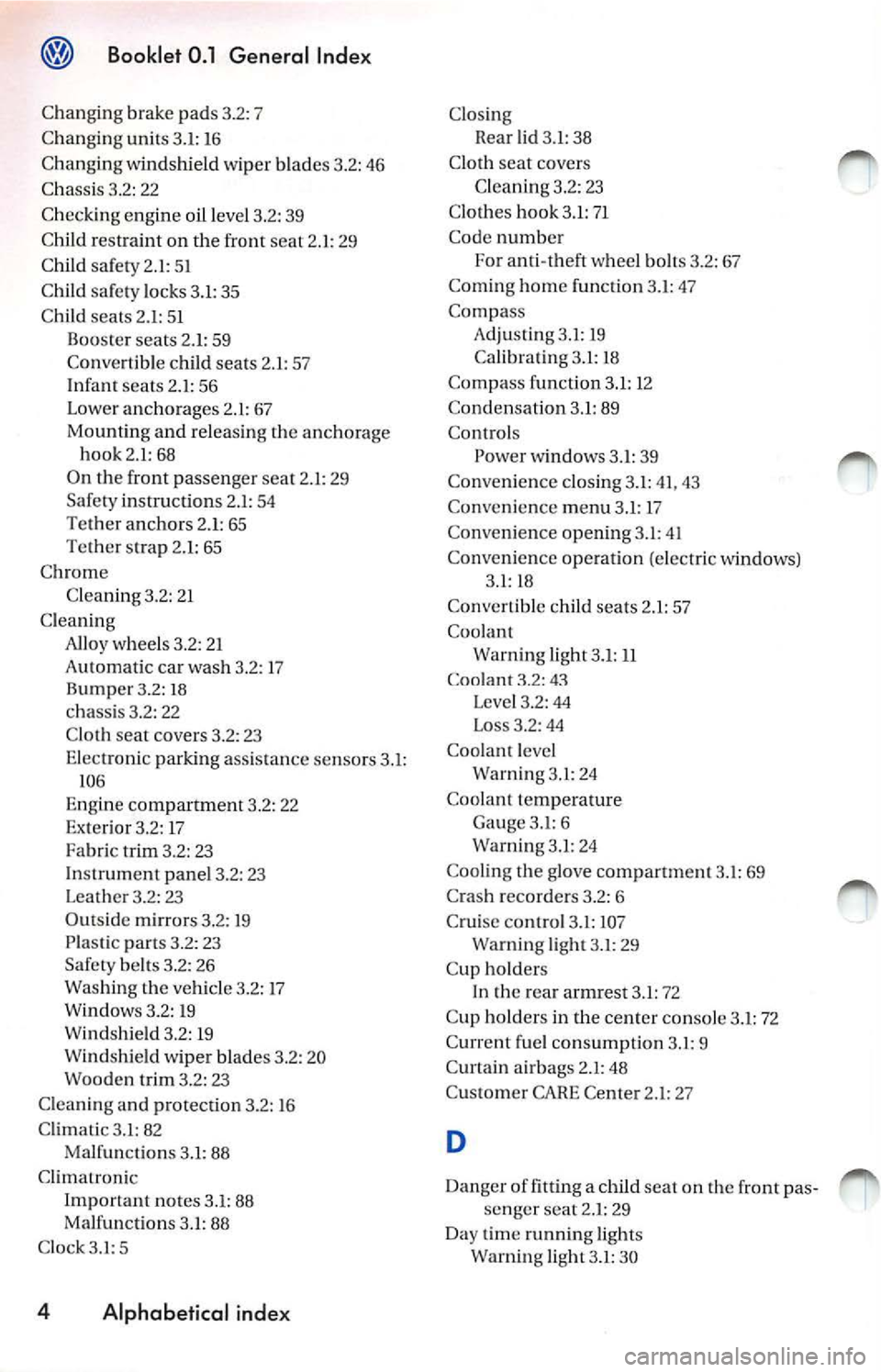
Booklet 0.1 General Index
Chang ing brake pa ds 3.2: 7
C hanging units 3.1: 16
C hanging w indshi eld w iper blades 3.2 : 46
C hass is 3.2: 22
C hec kin g engin e oil level 3.2: 39
Ch ild rest raint on th e fro nt seat 2.1: 29
Child safety 2.1: 5 1
Ch ild safety locks 3.1: 35
C hil d seats 2.1: 5 1
B ooste r seats 2.1: 59
Co nve rtible c hild seats 2. 1: 57
I nfa nt seats 2 .1: 56
L ower anc horages 2 . l: 67
Mo untin g and releas ing t he a ncho rage
h oo k2.l: 68
O n th e fr on t passenger seat 2.1: 29
Safety in struc tions 2.1: 54
Te ther an ch ors 2. 1: 65
Te ther strap 2.1 : 65
C hrom e
C lean ing 3.2 : 21
C lea nin g
All oy w hee ls 3.2: 2 1
A ut omat ic car was h 3.2: 17
B um per 3.2: 18
chass is 3 .2: 22
C lot h seat co vers 3.2: 23
Elect ronic par king ass is tance senso rs 3.1:
10 6
Eng ine com partm en t 3 .2: 22
Ex ter ior 3.2: 17
Fa bric tr im 3.2: 23
I ns tru ment panel 3.2: 23
L eat her 3.2: 23
O utside m irrors 3 .2: 19
P las tic p art s 3.2: 23
Safety belts 3.2: 26
Was hing t he ve hicle 3.2: 17
W ind ows 3.2: 19
W inds hield 3.2 : 1 9
W ind shi eld w ip er bla d es 3.2: 20
Woode n trim 3.2: 23
C lea ning a nd protec tio n 3.2: 16
C limatic 3.1: 82
Malfu nction s 3.1: 88
Cl imatro nic
Imp ortant no tes 3 .1: 88
Ma lfun cti ons 3.1 : 88
C lock3.I:5
4 Alphabetical inde x
Closing
R ear lid 3.1: 38
Clo th sea t covers
C lean ing 3.2: 23
C lo th es hook 3 .1: 71
Co de number
Fo r an ti-t heft w heel bolt s 3.2: 67
Coming home functi on 3.1 : 47
Co mpass
Adjusting 3.1: 19
Calibra ting 3.1: 18
Co mpass fun ction 3. 1: 12
Condensat io n 3.1: 89
Co ntro ls
Power wi ndows 3.1 : 39
Conven ie n ce clos ing 3.1 : 41, 43
Conve nie nce menu 3.1: 17
Conve nie nce ope ning 3.1: 4 1
Convenience operation (electric w in d ows)
3.1:
LB
C onve rtib le c hild seats 2 .1: 57
Coo lant
Warn ing ligh t 3. 1: 11
Coo lan t
Leve l 3.2: 44
Loss 3.2: 44
Coola nt level
Warni ng 3.1: 24
Co olan t tem pera ture
Ga uge 3.1: 6
Warning 3.1: 24
Cool ing the g love compartme nt 3.1: 69
C rash recorde rs 3.2: 6
Cru ise co ntro l 3 .l: 107
Warn ing ligh t 3.1: 29
Cup ho lders
I n th e rea r ar mre st 3.1 : 72
Cup ho lders in th e ce nter conso le 3 .1: 72
C urrent fuel con su mpt ion 3.1: 9
C urtain airbags 2.1: 48
Customer CARE Center 2.1 : 2 7
D
Danger of fi tting a ch ild seat on the front pas
senger seat 2 .1: 29
Day time runnin g lig hts
Warni ng ligh t 3.1: 30
Page 8 of 477

Daytim e dri ving light s 3.1: 46
D eac tivating th e sw itcha ble locking feature
2. 1: 63
Di ese l engi ne
Adding eng ine oil 3.2: 41
C ha nging engin e oil 3.2: 41
E ngin e oil 3.2: 4 1
E ngi ne oil sp ecifica tions 3.2: 37
Die sel ru el 3.2: 33
W int er operation 3.2: 33
Differential lock 3.2: 4
Di gital clock 3.1:
5
Display 3.1: 7, 12
Display s
O ne-co lor display 3.1 : 12
Distance between driver and steering wheel
2.1: 4
tra velled 3.1: 9
Door re le a se hand le 3. 1: 3
Do ors
Wa rnin g light 3.1: 26
Drain the ba tt ery 3 .1: 52
Driving economically 3.2 : 14
Dr iv in g o utside or the U. S.A . or Ca nada
Pr eca utio n s 3.2: 91
Driving sa re ty 2.1: 3
Drivi ng time 3.1: 9
Drivi ng w ith an aut oma tic tra nsmi ssion 3.1:
9 9
Driving with children 2.1: 51
Driv ing with respe ct
th e e nvironment 3.2:
14
Du st filter 3.1: 88
E
EDL3.2: 4
ED S
Warning ligh t 3. 1: 27
E lec tri c sea l adj ustm ent
See Sea t adjustm ent
El ec tr ica l accesso ries 3.1: 73
Book let 0.1 General Index ®
Elec trolyte level
C heck ing 3.2: 50
E lectro-mec hanical power steering syste m
Warn ing ligh t 3 .
l: 29
E le ctro nic Differen tia l Lo ck
Warning ligh t 3.1: 27
E lec troni c different ial lock 3.2: 4
E lec tronic immobilizer 3.1: 94
Warn ing light 3.1:
23
E lectro nic parking assistance 3.1: 106
E lectro nic Powe r C ontro l (EP C)
Warning light 3.1: 23
E lec tron ic S ta bili zation Program (E S P)
H ow it wo rks 3.2: 5
E lec tro nic S tabiliz ation Program 3.1 : 28, 9 1
Wa rnin g light 3.1: 28
E m erge ncy flashe r 3.1: 48
E m erge ncy wa rning ligh ts
Warn ing light 3.1: 24
E ng in e
Br ea k-in 3.2: 7
E ngine compartm ent
C leaning 3.2: 22
Pre cauti ons y ou shou ld take w hen work
ing inside the en gin e compa rtment 3.2 :
34
Wo rki ng in the en gine compartm ent 3.2:
34
Engi ne cool ant 3.2 : 43
A dditive s 3. 2: 43
C an
I add plain water to th e en gin e coo l
ant? 3.2 : 44
C oolant lo sses 3.2: 45
E n gi ne
Wa rnin g lig h t 3.1: 23
E n gine hood
Warning light 3.1: 26
Engine hood 3.2: 36
1 low do
! unlock the en gi ne ho od ? 3 .2: 36
E n gine
Wa rning lig ht 3. 1: 23
Engine management
Wa rnin g light 3.1: 23
Alphab etical index 5
Page 128 of 477
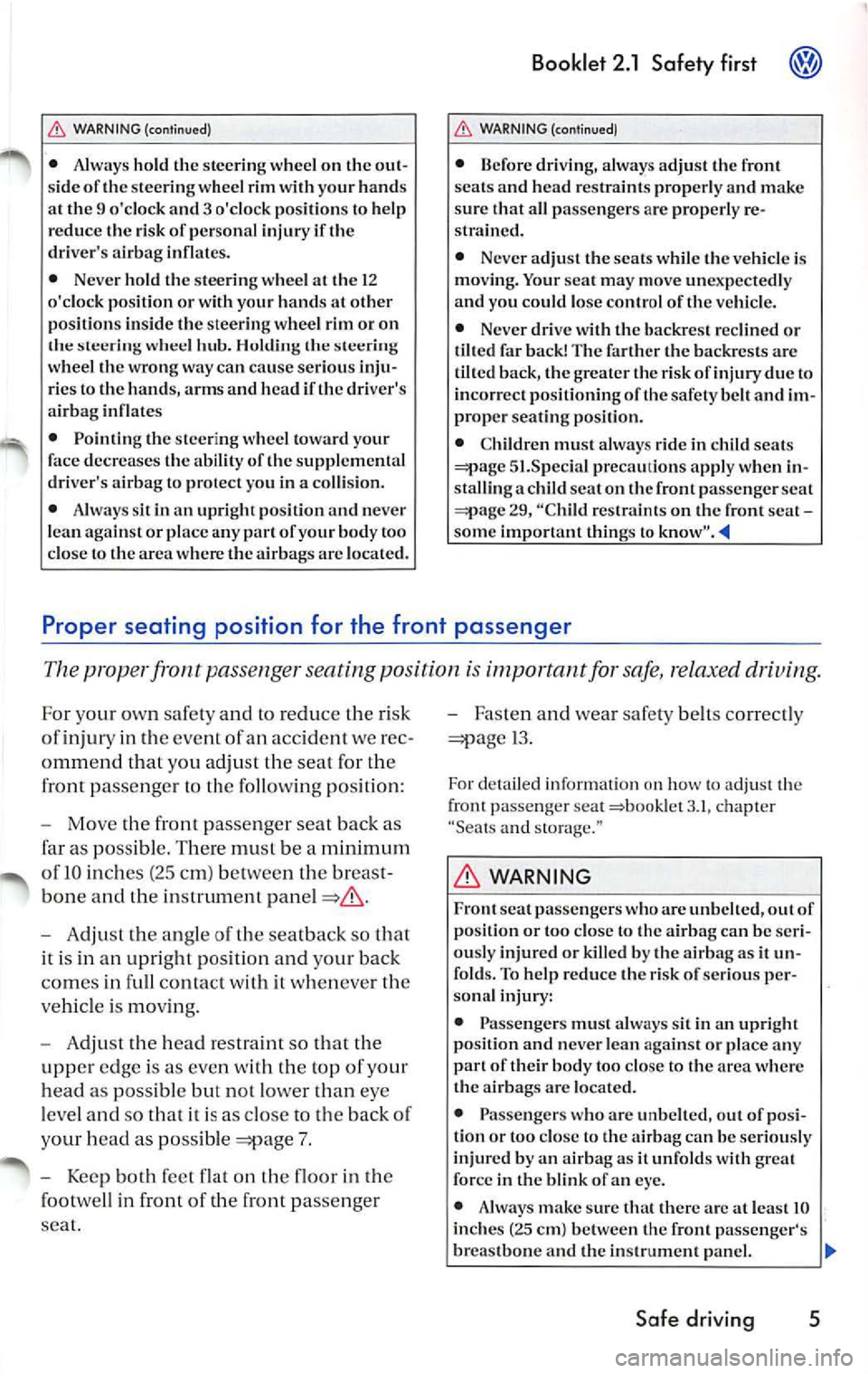
,&. WARNING (continued)
• Always hold th e steerin g w hee l o n th e out
s ide or the stee ring w heel rim with your h and s
at th e 9 o'clock and 3 o'cloc k p ositions to h elp
redu ce the risk or p erson al injury
• Neve r hold th e s tee rin g w hee l a t th e 12
o 'clo ck p osition or with your hand s at oth er
pos ition s in sid e th e stee ring w hee l rim or on
hub. ste erin g
w hee l th e wron g way c an cause ser ious inju
ri es to th e hand s, arm s and h ead
• P ointin g th e s tee rin g w hee l to war d your d ec reases the ability or the suppl em ental
driver's a irbag to p rotec t yo u in a collision.
• Always s it in an upri gh t p os ition and n ever
l e an a gainst or pla ce any part or y our bod y too
clo se to th e area w here t he a irbags are loc ated.
Booklet 2.1 Safety first
,&. WARNING (continu ed)
• B efor e dri vin g, a lways a djust the front
sea ts and h ead r est ra int s prop erl y a nd m ake
s ur e th at all passe nger s are properly re
s train ed.
• Neve r adju st th e sea ts w hil e th e vehicl e is
m ov ing. Y our seat m ay move unexpec tedly
a n d y ou could lose co ntrol of th e ve hicl e.
• Neve r drive w ith th e ba ckre st r eclin ed or
tilt ed
ba ck! Th e fa rth er the bac kres ts are
tilt ed b ack, th e g reater t he risk du e to
in co rrec t p ositionin g or the sa fe ty belt and im
prop er sea ting pos ition.
• Childr en mu st always ride in child seat s
51. Specl al p reca utio ns ap ply w hen in
s ta llin g a c hild sca t on th e fr ont passe nge r sca t
29, "C hild res trai nts on th e front scat some imp ort ant thin gs to
Proper seating position fo r the front passenger
The p roperf ront passenge r seating position is important for safe, relaxed driving.
For your own saf ety and to reduce th e r is k
of i njury in th e eve nt of an accide nt we rec
o mm end that you adjust the seat fo r th e
front pa ssenge r to th e fo llow ing po sitio n:
- Mo ve the front pas senge r sea t back a s
far as po ssibl e. There mu st be a mi nim um
of IO in ch es (25 c m) betw een the breast
bone and the in str um ent
- Adj ust th e ang le of th e s eatba ck so th at
it is in an upr ight pos it ion a nd your back
comes in full contact with it when ever the
ve hicle i s movin g.
- Adju st th e head restra int so th at the
uppe r edge is as e ven wit h th e top of yo ur
head as possible but not lower t han eye
le ve l and so that it is as close
the back of
yo ur h ead as po ssible
7 .
- Keep both fe et fl at on th e floo r in the
foorw ell in fro nt of the front pas senger
s eat. -
Faste n and wear safety be lts co rrec tly
13.
For d etai led informa tion on how to adju st th e
front passe nger seat 3.1 , chapter
"Sea ts and storage. "
WARNING
Front sea t passe ngers w ho arc unbelt ed, out or
p os ition or t oo close to the a ir b ag c an b e ser i
ou sly inju re d or kill ed by th e a ir ba g as i t un
fo lds. To h elp re du ce the r is k or se rio us p er
so nal inj ury :
• P assenge rs mu st a lways si t in an u pri ght
p os ition and n ever le an aga inst o r p lace any
p art o r th eir b ody too close to th e a rea w here
th e air ba gs arc locat ed .
• Passe ngers who a rc unb elt ed , o u t o r posi
ti on or t oo cl ose to t he a irbag can be se riously
in jur ed by a n airb ag as
it unfold s w ith grea t
for ce in the b link or a n eye .
• Always make s ure th at th ere a rc at leas t 10
in ch es (25 cm) bet wee n t he front p assenge r's
br eas tbone and th e ins trum ent p anel.
Safe driving 5
Page 142 of 477
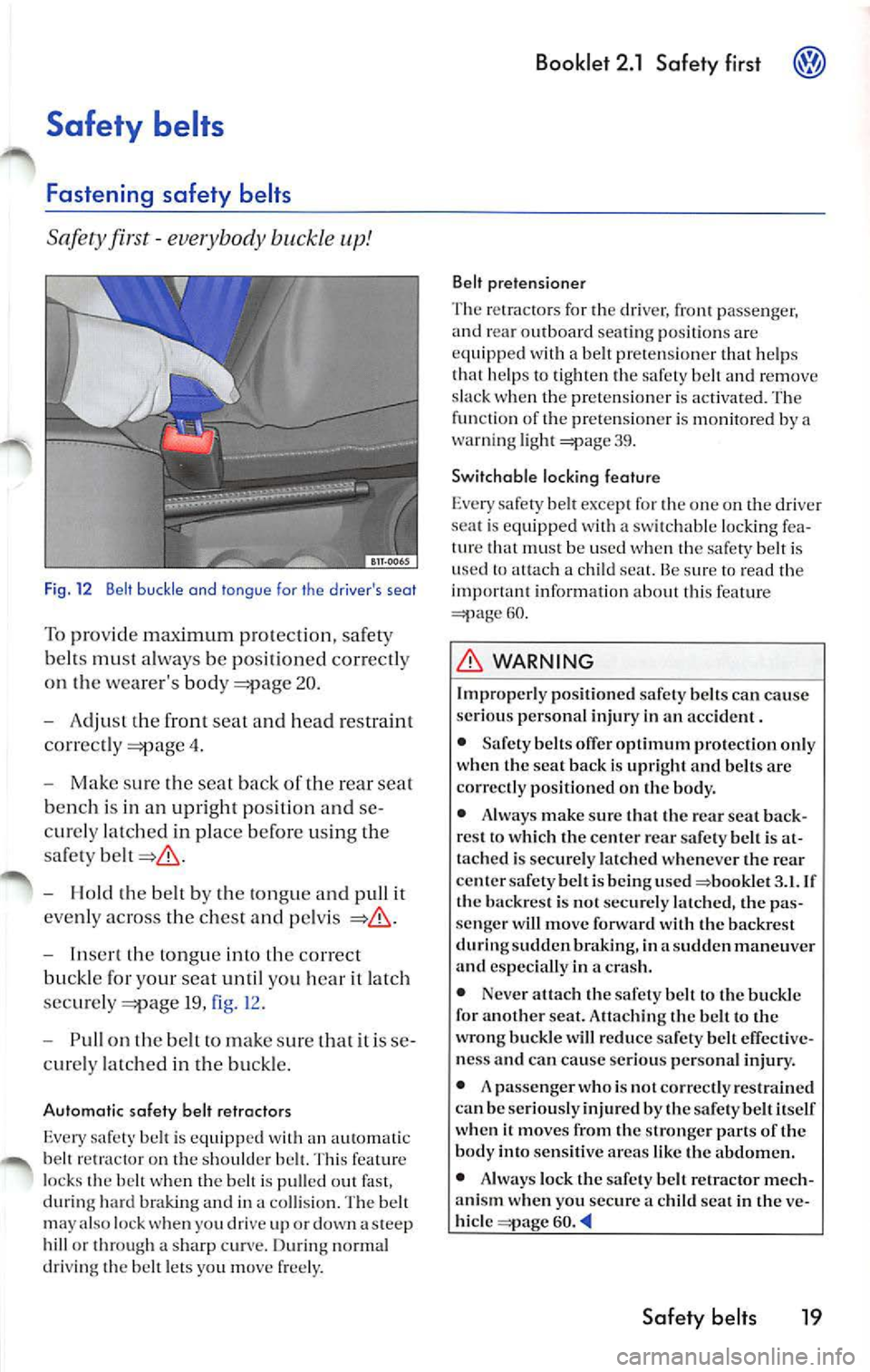
Safety belts
Fastening safety belts
Sa fe ty fir st -eve rybody buckle up!
Fig. 12 Belt buck le and tongue fo r th e dr iver's seat
To pro vid e maximum prot ectio n, sa fety
b elt s
alw ays be po siti oned cor rectly
o n
weare r's bod y 20.
- Adju st
fro nt sea t and head restra int
co rrec tly
4.
- Mak e su re th e seat back of the rea r sea t
b ench i s in an upright pos ition and se
cu rely latche d in plac e before usin g th e
sa fe ty
- Hold !he be lt b y ton gu e and pull it
eve nly across the ch es t and pel vis
-th e tongue into correct
bu ckle for your seat until you h ear
latch
sec urely
19, fig. 12 .
- Pull on
belt to mak e sure that it is se
cure ly latc hed in the bu ckle.
Automatic safety belt retractors
E ve ry
b elt i s equipp ed with an aut om ati c
belt retrac tor on th e sho uld er bell. Thi s fea ture
l oc ks th e belt when the
is pu lled ou t fast ,
during hard braking and in a collision. The belt
m ay also lock
yo u d rive a stee p
hill or thro ugh a sh arp cur ve. Durin g no rma l
dri vin g th e belt le ts yo u mo ve freel y.
Booklet 2 .1 Safety first
Belt prete nsio ne r
T he re tracto rs for the drive r,
pa sse nger,
a nd rea r outboard seating po sition s are
e quipp ed wit h a belt pr ete nsio ner that h elp s
th at h elp s to t ight en th e safe ty belt and remo ve
s lac k w hen th e pr etens ioner is act iva te d. Th e
fun ction o f the pr eten sio ner is m onit ored b y a
wa rnin g light
39.
Switc hable l ocking feature
Every safety belt excep t fo r th e one on th e dr ive r
se at is eq uippe d wit h a sw itchable locking fea
tur e th at mu st be use d when the saf ety b elt is
used
1 0 att ach a child seal. Be sur e to read the
imp orta nt in formation about thi s feature
60 .
WARNING
Imp roperl y position ed safe ty belt s ca n ca use
se riou s personal injury in an accident.
• Saf ety belts offer optimum protection only
when the seat back is upright and belt s arc
c o rr ectly positioned on the body.
• Alway s m ake sure that th e re ar sea t back
res t to which th e center re ar safety belt is at
t ached is sec urely la tc h ed when ever th e rear
center safety belt i s bei ng use d
3.1. If
the b ackres t is n ot sec urely latc hed, the pa s
s enger will move fon vard wit h the backres t
during sudden braking, in a sudd en maneuver
a nd especially in a cras h.
• Never attach the safe ty belt to the bu ckl e
for another seat. Attachi ng the belt to th e
wrong buckle will reduce safety belt effective
ness and can cause se rious per sona l injury .
• A pa ssenge r w ho is not corre ctl y restrain ed
can be se riou sly injur ed by th e sa fe ty belt it self
w hen
60.
Safety belts 19
Page 163 of 477
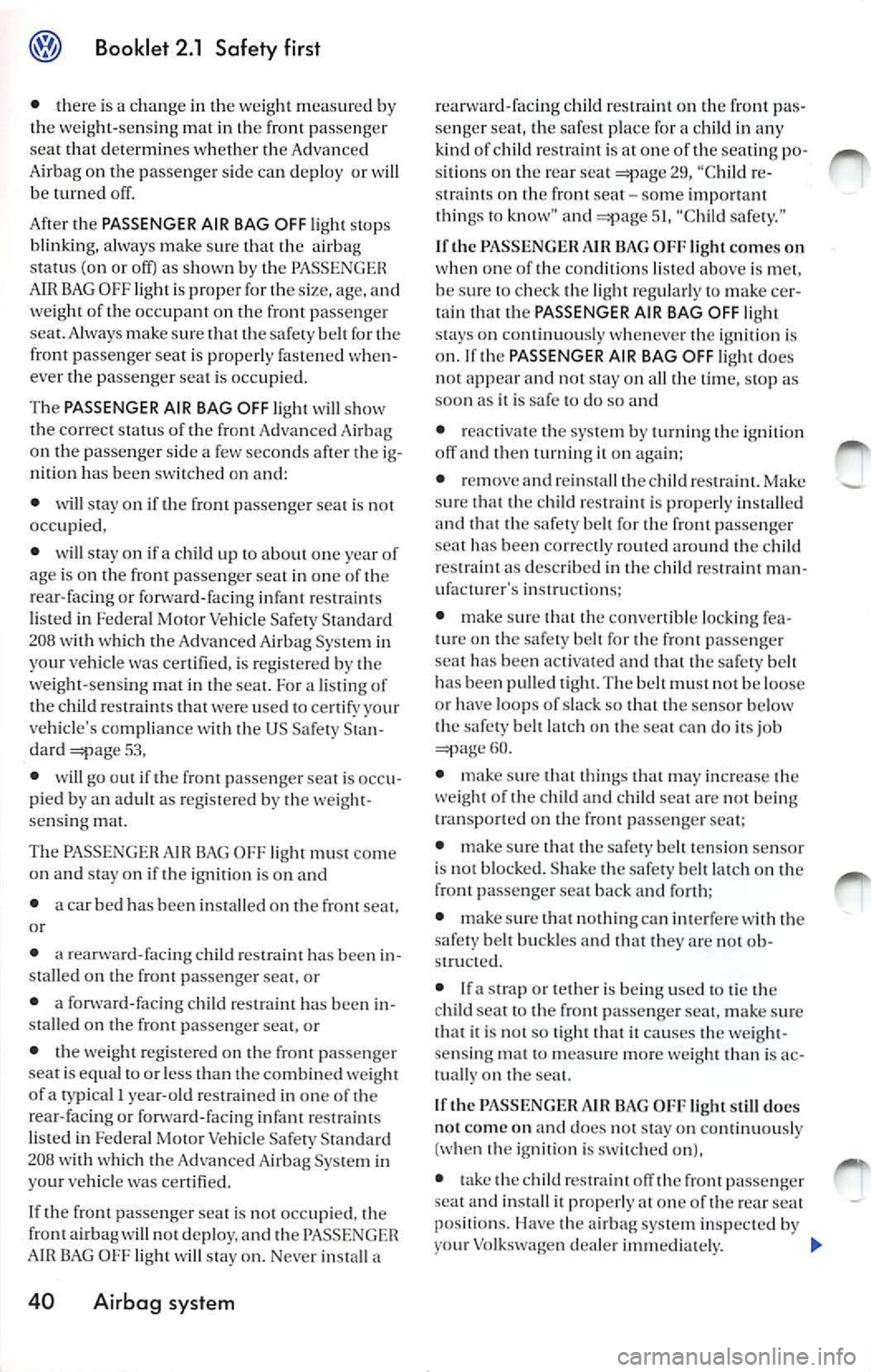
@ Booklet 2.1 Safety first
• there is a c han ge in the we ight mea sur ed by
th e we ig h t- se n sing mat in th e fro nt pas se nge r
s ea t th at d ete rmin es wheth er th e Adva nced
Ai rbag o n the pass eng er s id e ca n dep lo y or w ill
be t urn ed off.
Aft er th e PASSENGER AIR BAG
OFF lig ht stop s
b lin kin g, a lwa ys mak e sure that t he airbag
s tat us ( on or off) as show n by the PASS ENG ER
A lR B AG OFF lig ht is prop er fo r th e size, age , a nd
we ig h t of the occupant o n the fron t pa ssenger
s ea t.Alwa ys mak e s ure that th e
b elt f or th e
fr ont pa sseng er sea t is p roperl y fa ste n ed whe n·
ev er th e pa sse nge r seat i s occ upi ed.
T he PASSENGER AIR BAG
OFF ligh t w ill sh ow
th e c orre ct sta tu s of th e fron t Ad vance d Air b ag
on th e pa sse nger sid e a few sec onds after t he
niti on h as be en sw itc h ed on and:
• will sta y o n if t he fron t pa ssen ger sea t is no t
o ccupi ed,
• will sta y on if a child up t o ab out one yea r o f
ag e is o n th e front passe nger seat in one of th e
r e a r- fa cin g or fo rw ard -facin g in fant r estra int s
list ed in F edera l M oto r Ve hicl e Safety S ta nd ard
2 08 w it h whic h t he A dva nce d Airbag Syste m i n
y our vehicle was ce rtified, is reg is te re d b y th e
w eig ht- sensing m at in th e sea t. Fo r a listin g of
th e c hild res traint s th at we re use d t o ce rtify your
ve hicl e's co mplianc e w ith th e US Safe ty
d a rd 5 3,
• will go ou t if the fro nt passe nge r se at is
pi ed b y an adult as reg is te re d b y th e se nsi ng m at.
Th e PASSENGE R AIR BAG O FF lig ht must come
o n and stay o n if the ig nit io n i s o n a nd
• a car b ed has bee n in stall ed on th e fro nt sea t.
o r
• a rear wa rd-faci ng c hild res tra int has bee n
sta lled on th e fro nt p asse nger seat, or
• a forwa rd-fa cing c hild r estraint h as been
sta ll ed on th e fron t p asse nge r sea t, or
• th e we ig ht r egis tered o n the front passe nge r
s eat is equ al to o r less than th e co mb in ed weig ht
o f a ty pi ca l I ye ar- old res tra in ed in one o f th e
rea r-fac in g o r fo nva rd-faci ng in fa nt re s tra int s
li ste d in F ed era l Moto r Ve hicle Saf ety St andard
208
w hic h th e Adva nce d Ai rb ag Sys te m in
yo ur vehicl e w as ce rtifi ed .
I f th e front passe nge r sea t is not occ upied , th e
fr ont a ir b ag w ill not de ploy, and t he PASS ENG ER
OF F light will sta y o n. Nev er a
40 Airbag system
re ar ward-facing chil d res traint on the front se nger seat, the sa fest pla ce for a chil d in an y
k ind of c hild r estra in t is at on e of t he sea ting
sit ion s on t he rea r se at 29, " Chil d strai nts on th e front seat-so me import ant
th ings to kn ow " a nd 51, "C hild safe ty ."
If th e PASSENGE R
AIR BAG OFF light come s on
w hen one of t he co ndit io ns liste d ab ove is m et,
b e s ure
c h eck the li gh t r eg ula rl y to m ake tai n th at th e PASSENGER AIR BAG OFF lig ht
s tays o n co ntinu ously w hen eve r th e ig nit io n is
o n. I f th e PASSENGER AIR BAG
OFF light does
n ot app ear and no t stay o n all th e time, sto p as
soo n as it is safe to d o so a nd
• re ac tiva te th e sys te m b y turn in g th e ig n iti on
off and th en t urni ng it on a gain ;
• re m ove a nd re in stall t he child res traint. Mak e
s ur e that th e c hild r estra int is prop erly in sta lled
and th at th e saf ety be lt for t he front p asse nge r
sea t has bee n co rrec tly rout ed aro und th e child
r es traint a s desc ribed in th e ch ild r estra int
in struc tio ns;
• make sur e th at th e co nve rtib le lock in g
tu re o n th e safe ty belt fo r the front p asse nge r
sea t has bee n ac tivated a nd th at th e sa fety belt
h as bee n pulled ti gh t. The be lt mu st n ot b e loose
or have loops of s lack so th at t he se nsor below
t h e
be lt la tc h on th e se a t ca n do its jo b 60.
• make su re th at th in gs that m ay inc rease th e
we ig ht of the c hild and chi ld sea t a re not bein g
t ra nspo rted on th e fro nt passe nge r sea t;
• make s ure th at th e
belt tens io n se nsor
i s not blocke d. S hake th e sa fe ty be lt la tc h on th e
fro nt passe nger sea t bac k and forth;
• make s ure th at n oth in g ca n i nte rfe re w ith t he
safe ty be lt bu ck les and th at th ey a re not
stru cte d.
• If a stra p or te th er i s bein g used to tie th e
c h ild sea t to th e fro nt passe nge r seat, make sur e
that it i s
110 1 so tig ht that it ca uses the sensin g ma t to meas ure m ore we igh t th an is t u ally on th e se at.
If the PA SSE NGER AIR
light still doc s
n ot co me o n and docs not s tay on co nti nuo usly
(w hen th e ig nit ion i s sw itch ed on),
• take th e ch ild res tra in t o ff t he fro nt passe nge r
sea t a nd in sta ll i t prope rly
at on e of t he rea r sea t
pos itions. Ha ve the airbag sys tem in spec ted by
Vo lkswage n deale r
Page 177 of 477
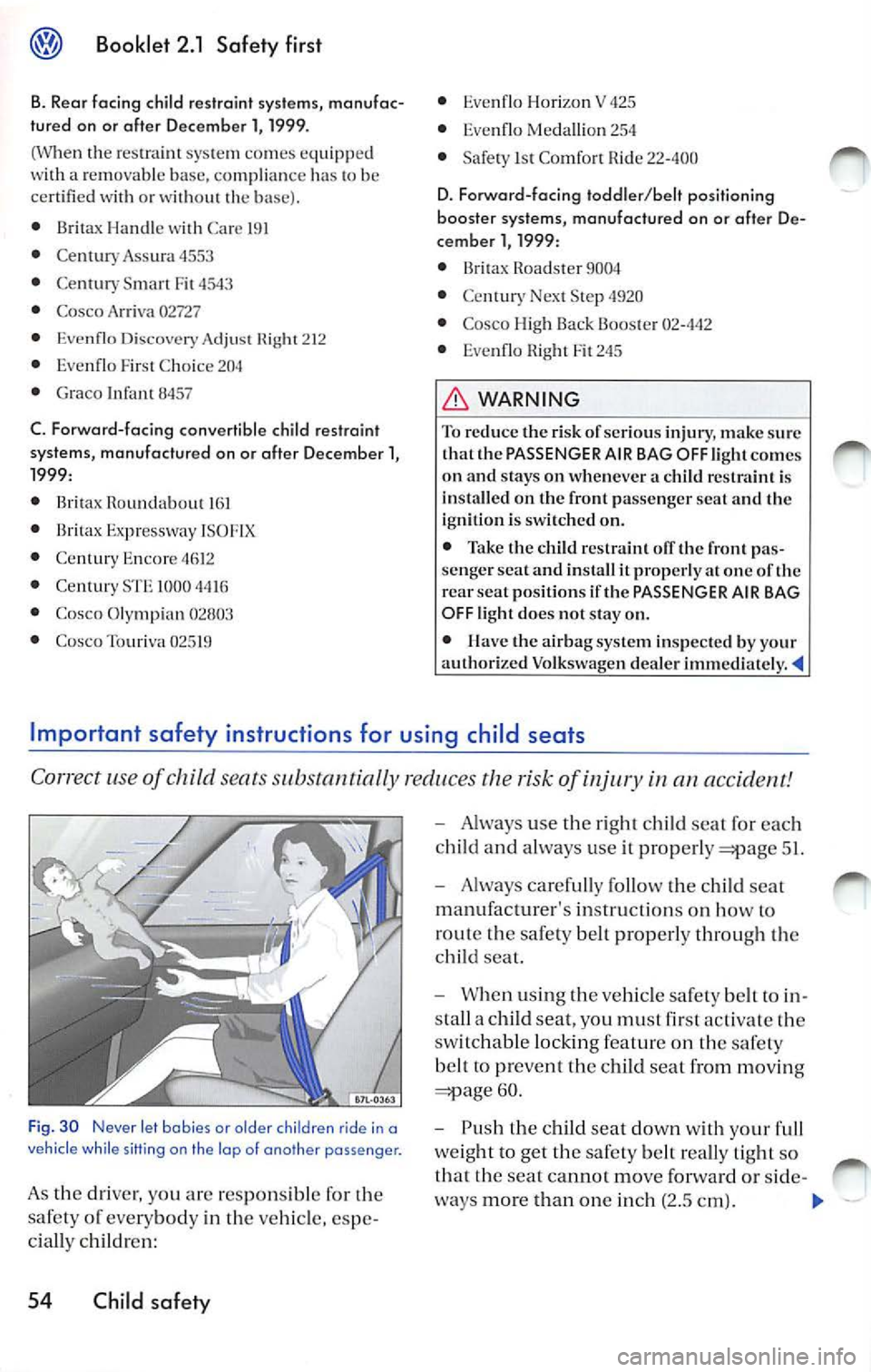
Booklet 2.1 Safety first
8. Rear facing child restraint systems, manufac
tured on or alter December l, 1999.
( W hen the res tra in t sys te m comes e quipp ed
w ith a re mo vable ba se, co mpli ance ha s to be
ce rtified with or wit hout the ba se).
• Britax Hand le wit h Care
191
• Centur y Ass ura 4553
• Centu ry Sm art Fit 4 543
• Cosco Arriva 02727
• Eve nflo Disc overy A dju st 212
• Evenflo Fir st Ch oice
204
• Gra co Infant 8 11 57
C. For war d-facing convertible child res trai nt
systems, manufactured on or after Dece mber l ,
1999:
• Brit ax Rou ndabou t
161
• Brit ax Expressway J SOFIX
• Centur y Enco re
• Century 1000
• Cosco Ol ymp ia n 0280 3
• Cosco Touriv a 02519
• Even flo Horizon V 425
• Evenfl o Meda llion 25 4
• Saf ety 1s t Co mfort Ride 22-400
D. Forward-fac ing toddler /be lt po sitioning
booster systems, manufactur ed on or after D e
cember l, 1999 :
• Brita x Roadster
9004
• Century Next Step 4920
• Cosco High Back Booste r
• Eve nfl o Hig ht Fit 2 45
L'.0, WARNING
To redu ce the ri sk of serio us inju ry, mak e sur e
that the PASSENGER AIR BAG OFF li ght comes
on and sta ys on when eve r a child restraint is
in stall ed on the front pa ssenger sea t and the
ignition is switched on.
• Take the child res traint
the front pa s
s enger seat a nd install it properl y at one of the
rear seat position s if th e PASSENGER AIR BAG
OFF light does not sta y o n.
• Have the airbag system insp ec ted by yo ur
aut hori zed Volkswag en dealer immediately.
Important safety instructions for using child seats
Correct use of chil d seat s substant ially reduce s the risk of injury in an ac cident!
Fi g. 3 0 Neve r le t babi es or older c hildren rid e in a
v ehicl e wh ile s itting on th e lop o f a no th er passenge r.
As the driver, yo u ar e res pon sible for th e
s a fety of eve ry bod y in th e ve hicle , espe
ci all y chil dren:
54 Child safety
-Alway s use the right child seat for each
c hi ld and alwa ys use it prop erly
51.
- Alw ays caref ully foll ow the child seat
m anu fac turer 's in stru ction s on how to
rou te the sa fe ty bel t pr oper ly throu gh
child seat.
- When usin g th e ve h icle safety belt
10 in
s ta ll a child seat, you must fir st a ctivat e
sw itchab le lock ing fea tur e on th e safe ty
b elt
p reven t th e child seal from mov ing
60.
- Push th e c hild sea t d ow n with yo ur full
weig ht to get the sa fe ty belt re all y light so
th at the seat cannot mov e for ward or side -
w ays more th an one inch (2.5 cm ).
»,,
Page 180 of 477
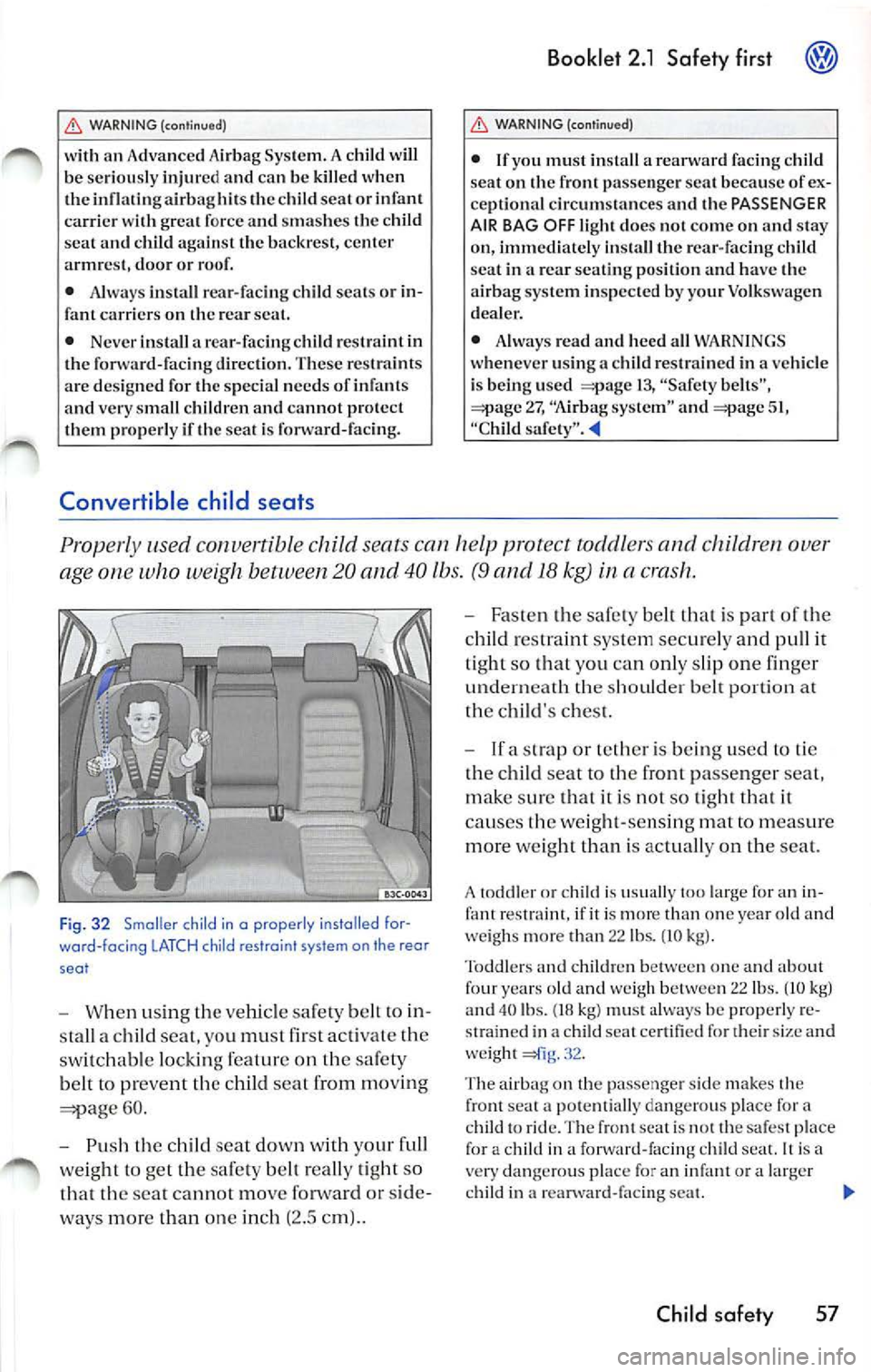
WARNING (continu ed)
with an Advanced Airbag System . A chi ld will be seriously injur ed and can be killed when
the infl atinga irb aghil s the child seal or infant
ca rri er w ith grea t force and smashes the c hild
sca t and child against the backres t, cen te r
arm res t, door or roo f.
• Alwa ys install rea r-facing child seats o r
fant carriers on the rear scat.
• Never install a rear-facing child r estraint in
the forward-facing direction . These restra ints
a rc des ig n ed for th e speci al needs of infants
and very small children and cannot prote ct
th em prope rly if the seat is fo rwa rd-faci ng.
Convertible child seats
Booklet 2.1 Safety first
WARNING (continued)
• If you must in sta ll a rear ward facing child
sca t on the front passenger sca t because
cept ional circ umstances a nd th e PASSENGER
AIR BAG OFF light does not come on and stay
on, immediately install the r ear -fa cin g child
sea t in a rear seating position and have the
a irba g sys tem inspected by your Volkswage n
d ea ler.
• Alwa ys re ad and heed all WARN INGS
w hen ever usin g a child r estrain ed in a vehicle
i s bein g used
13, "Safety belts", 27, "A irbag sys tem" and 51,
"C hild
Prop erl y convertible child seats can help protect toddlers and ch ildre n over
age one who weigh. between 20 and 40 lbs. (9 and 18 kg)
a crash..
Fig . 32 Smal ler child in a properly i nstalled for ·
wa rd -fac ing LATCH child restra int system on the rear
seot
- When using the vehicle safety belt to
s ta ll a c hild sea t, y o u must fir st ac tiva te the
s w itch able locki ng fea tur e on the sa fety
belt to prevent the child sea t from movin g
60 .
Pu sh the ch ild seat clown with your full
weig ht to get the sa fe ty belt rea lly tight so
tha t th e sea t cannot move forwa rd or sid e
ways more t han one inch (2.5 cm ) ..
Fa ste n th e safe ty belt that is part of the
c hild r estraint system securely and pu ll it
t ight so that yo u ca n onl y s lip one finger
unde rnea th th e sh o ulder belt portion at
the c hild's ch es t.
If a strap or teth er i s bein g used to tie
the c hild seat to the
passe nger scat,
make sur e th at i t is not so tight tha t it
ca uses the weig ht-sens ing mat to meas ure
more w eig ht tha n is ac tually on the seat.
A to ddl er o r child is usu ally 10 0 large for an restraint , if it i s mor e than on e year old and
we igh s mor e th an 22 lbs. (JO kg).
Todd lers and child re n b etween o ne and abo ut
fou r ye ars old and w eigh betwe en 22 lbs. (10 kg)
and 40 lbs. (18 kg) mu st alway s be properl y
str ai ned in a child scat ce rtifi ed fo r th eir size and
we ig ht 32 .
The airbag on the pa sse nge r side
th e
fr ont sea t a p ote nti ally dange rou s plac e for a
c hild to rid e. The fr ont scat is not th e safe st p lace
for a chi ld in a forward-facing child seat. It is a
v ery dangero us pla ce for an
or a large r
c hild in a r earward-faci ng se at.
Child safety 57
Page 183 of 477
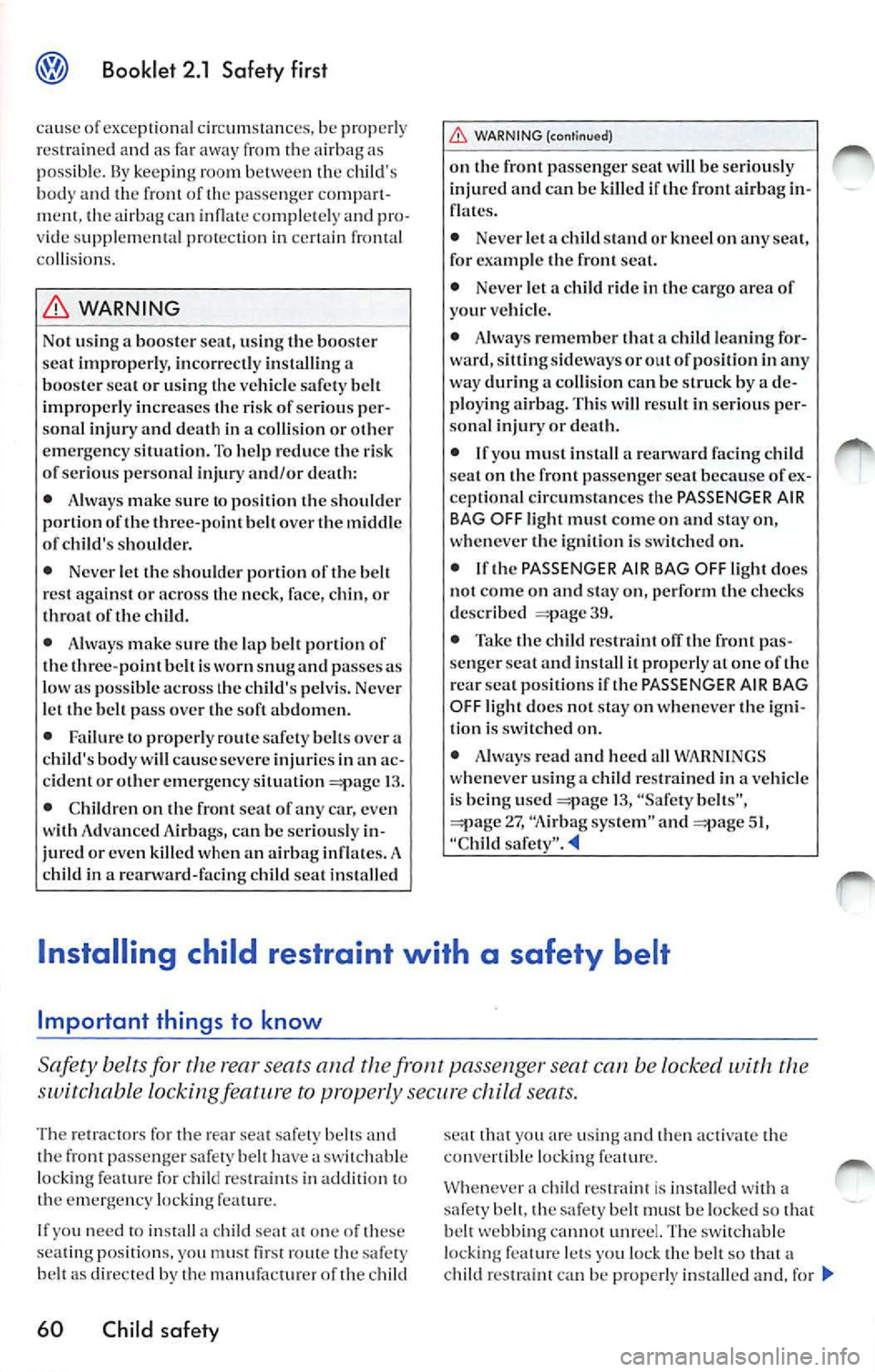
Booklet 2.1 Safety first
cause of exceptional circum stances, be properl y
r es train ed and as far away from th e airb ag as
poss ible.
lly keeping ro om b etwe en the child 's
body and the front of th e pa sseng er co mpart
the airbag can inflat e co mple te ly and pro
v id e s uppl emental protection in certain fr ontal
c olli sions.
WARNING
No t usi ng a booster seat, using the booster
scat improp erly, inco rrec tly in sta llin g
booster seat or u sin g the veh icle safety belt
improp erly increases the ri sk of ser iou s p er
sonal injury and death in a co llisio n or other
e m ergency s ituation. To help reduce the risk
of serious personal injury and/or death:
• Always make sure to position the should er
portion of the three-point belt over the middle
of chi ld's shoulder.
• Never le t the sh o uld er portion of the belt
r es t again st or across the neck, face, chin, or
th roa t of the ch ild.
• 1\Jway s make sure the lap belt portion of
th e thr ee-po int belt is worn s nug and pas ses as
l ow as possib le across the child 's pelvi s. Neve r
l et the belt pass over the soft abdome n.
• Failure
10 properly rou le safety belt s over chi ld's body will cause severe injuries in an ac
cident or other em erge ncy s ituation 13.
• Children on the front scat of any car, eve n
w ith Adva nced Ai rbags, can be serious ly in
jured or even killed when an airbag inflates. A
ch ild in a rea rw ard-fac ing ch ild sca t installed
WARNING (continu ed)
on the front pas senger seat w ill be serious ly
injured and can be killed if the front a irbag in
flates.
• Never le t a ch ild stand or kneel on any seat,
for examp le the front scat.
• Never let a child ride in the cargo area of
your ve hicle.
• Always remember that a child leaning for
ward, s itting sideways or out of po sition in any
way during a collisio n can be struc k by a de
ploying
Thi s w ill r esult in seriou s per
so nal injur y or death.
• If you must in stall a rcanvard facing child
sea t o n th e front passenger scat becau se of ex
cept ional circum stance s the PASSENGER AIR
BAG
OFF light must come on and stay on,
whenever the ignition is switch ed on .
• If th e PASSENGER AIR BAG
OFF light does
not come on and stay on, perform th e checks
described
39.
• Take the child restr aint olT the front pa s
se nger seat a nd install it properly at one of the
r ear seat pos itions if the PASS ENGER AIR BAG
OFF light docs not stay on whenever the ig ni
tion i s switched o n.
• Always read and heed a ll WARN INGS
whenever using a c hild restrained in a vehicl e
i s bei ng used
13, "Sa fety belt s", 27, "A irb ag sys tem" and 51, "Child safe ty" .
Installing child restraint with a safety belt
Impo rtant t hin gs to kno w
Safety belts for the rea r seats and thefro nl passenger be locked with the
switchable lockingfeature to properly secur e child sea ts.
Th e retractors fo r th e rear sear safe ty belt s and
th e front passenger safety belt have sw itchabl e
l oc kin g fea tur e for chil d res traint s in addition to
emerge ncy lo ckin g fe a ture.
I f yo u need to insta ll a ch ild sea t
one of these
sea ting po sition s, y ou mus t first route the safe ty
b elt as dire cte d b y
manufactur er o f th e ch ild
60 Child safety
seat that you arc using th en act ivate the
convertib le lockin g fe ature.
Whe neve r a ch ild restrai nt is installed
a
sa fe ty th e safe ty belt must b e locke d so that
b elt web bing cannot unr eel. Th e sw itchabl e
l oc kin g fea tur e le ts you lock the belt so that a
c hild r estraint
be prop erl y in sta lled and. for tii,